
Keeping astronauts breathing aboard the International Space Station and other space vehicles is a complicated and costly process. As humans plan future missions to the Moon or Mars, better technology will be needed.
Now, an international team of scientists, including a University of Warwick chemist, has proposed a potentially better way to make oxygen for astronauts in space using magnetism. The technology marks an important breakthrough in the production of oxygen from water in the absence of buoyant forces.
“On the International Space Station, oxygen is generated using an electrolytic cell that splits water into hydrogen and oxygen, but then you have to get those gasses out of the system,” said lead author Álvaro Romero-Calvo, a recent Ph.D. graduate from the University of Colorado Boulder. “A relatively recent analysis from a researcher at NASA Ames concluded that adapting the same architecture on a trip to Mars would have such significant mass and reliability penalties that it wouldn’t make any sense to use.”
The lack of gravity makes it difficult to extract oxygen in space. On Earth, the bubbles of CO2 quickly float to the top in a glass of soda, for example. But in the absence of gravity, like in space, those bubbles have nowhere to go. They instead stay suspended in the liquid. NASA currently uses centrifuges to force the gasses out, but those machines are large and require significant mass, power, and maintenance. Meanwhile, researchers have conducted experiments demonstrating magnets could achieve the same results in some cases.
Diamagnetic forces are well known and understood; however, their use by engineers in space applications has not been fully explored because gravity makes the technology difficult to demonstrate on Earth. For their study, the authors turned to the Bremen Drop Tower in Germany, a 146-meter-tall (480-ft) scientific facility that simulates microgravity conditions.
There, the team developed a procedure to detach gas bubbles from electrode surfaces in microgravity environments generated for 9.2 seconds at the Bremen Drop Tower. The study demonstrates for the first time that gas bubbles can be attracted to and repelled from a simple neodymium magnet in microgravity by immersing them in different types of the aqueous solution.
Professor Hanspeter Schaub of the University of Colorado Boulder said: “After years of analytical and computational research, being able to use this amazing drop tower in Germany provided concrete proof that this concept will function in the zero-g space environment.”
According to the scientists, the research could open up new avenues for scientists and engineers developing oxygen systems as well as other space research involving liquid-to-gas phase changes.
“These effects have tremendous consequences for the further development of phase separation systems, such as for long-term space missions, suggesting that efficient oxygen and, for example, hydrogen production in water (photo-) electrolyzer systems can be achieved even in the near-absence of the buoyant-force,” said Dr. Brinkert.
Using magnets to generate oxygen from water for astronauts
Source: Tambay News

0 Comments